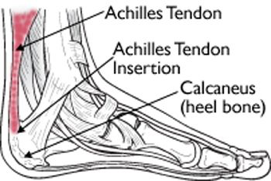ADVICE
Is Your Achilles Heel Your Achilles Heel?
Achilles’ only weakness in his otherwise invincible body was his heel. Left unprotected because of his mother’s failure to immerse it along with the rest of his body in the river Styx, a poisonous arrow piercing the heel ultimately ended his life. (NB It’s always the parents’ fault)
Fortunately, I’m able to assure you that Achilles pain isn’t a fatal condition and a full recovery can usually be expected.
The Achilles tendon (also known as the Calcaneal tendon) attaches the calf muscles to the calcaneus (heel bone) and withstands large forces with every step we take. Whilst walking the force is equivalent to almost four times body weight, and when running, seven times body weight.
Achilles Tendinopathy is an umbrella term that encompasses both swelling (tendinitis) and degeneration of the tendon (tendinosis). Although we tend to hear more often about Achilles tendinitis, tendinosis is the more common condition; usually an overuse injury, often age related and frequently not attributable to sporting activity.
Indications of Achilles tendinopathy are a gradual onset of pain and stiffness of the Achilles tendon, usually worse in the mornings, but easing as the day progresses. It will probably be painful at the onset of exercise, easing through the session, and worsening again once ceases. Pain can be reproduced by “pinching” the tendon between your fingers.
There are two types of Achilles tendinopathy, the first known as Midpoint Tendinopathy where pain is felt 2-3cm above the calcaneus and the second, which is less common, Insertional Tendinopathy, where the tendon attaches to the heel bone.
Factors that increase your chances of suffering from Achilles tendinopathy are both within your control and not. They include: –
- Foot biomechanics – over pronation of the foot causes the lower leg to rotate inwards and “twist” the Achilles tendon. Gait analysis will indicate whether you’re wearing the right shoes or if you have muscular imbalances that can be addressed.
- Age and gender – tendinosis often coincides with middle age with men more likely to suffer than women.
- Increasing running mileage too quickly – weekly distance shouldn’t be increased by more than 10%.
- Running uphill causes the Achilles tendon to work under load in a stretched position which can cause wear and tear. Stop any activity that causes Achilles pain.
- Regularly wearing high heels causes the calf muscles to shorten and the Achilles tendon to become thicker, which can cause pain when bare foot or wearing flat shoes. Stretching the calves after wearing heels will help prevent the problem developing or becoming worse.
Treatment protocol depends on whether you’re suffering from midpoint or insertional tendinopathy, although there is some overlap. Here are a few ideas to begin with, although I would always urge you to see a qualified physiotherapist or sport and remedial massage therapist for treatment and a personalised rehabilitation programme.
- If there is swelling, ice the area for 15 minutes every couple of hours.
- Wearing a heel lift can help ease pain.
- Self-massage the calf muscles using a foam roller.
- Perform heel raises daily, progressing each day but keeping the level of discomfort low – with insertional tendinopathy it’s important not to drop the heel below toe-level as this will load the tendon at the insertion point but do speak to a qualified practitioner for a personalised programme
Achilles tendinopathy can take between 6 weeks to 6 months to rehabilitate. It can be a stubborn and frustrating injury, but you can overcome it!

